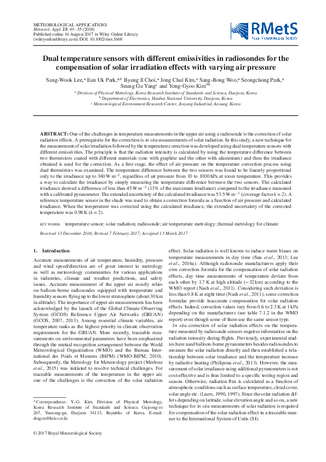One of the challenges in temperature measurements in the upper air using a radiosonde is the correction of solar radiation effects. A prerequisite for the correction is in situ measurements of solar radiation. In this study, a new technique for the measurement of solar irradiation followed by the temperature correction was developed using dual temperature sensors with different emissivities. The principle is that the radiation intensity is calculated by using the temperature difference between two thermistors coated with different materials (one with graphite and the other with aluminium) and then the irradiance obtained is used for the correction. As a first stage, the effect of air pressure on the temperature correction process using dual thermistors was examined. The temperature difference between the two sensors was found to be linearly proportional only to the irradiance up to 360 W m−2, regardless of air pressure from 10 to 1000 hPa at room temperature. This provides a way to calculate the irradiance by simply measuring the temperature difference between the two sensors. The calculated irradiance showed a difference of less than 45 W m−2 (13% of the maximum irradiance) compared to the irradiance measured with a calibrated pyranometer. The extended uncertainty of the calculated irradiance was 53.5 W m−2 (coverage factor k = 2). A reference temperature sensor in the shade was used to obtain a correction formula as a function of air pressure and calculated irradiance. When the temperature was corrected using the calculated irradiance, the extended uncertainty of the corrected temperature was 0.98 K (k = 2).
Title
Dual temperature sensors with different emissivities in radiosondes for the compensation of solar irradiation effects with varying air pressure
Authors
Lee, S.-W., Park, E.U., Choi, B.I., Kim, J.C., Woo, S.-B., Park, S., Yang, S.G. and Kim, Y.-G.
Published
by Meteorological Applications (MA) at 2017-08-16
Abstract
